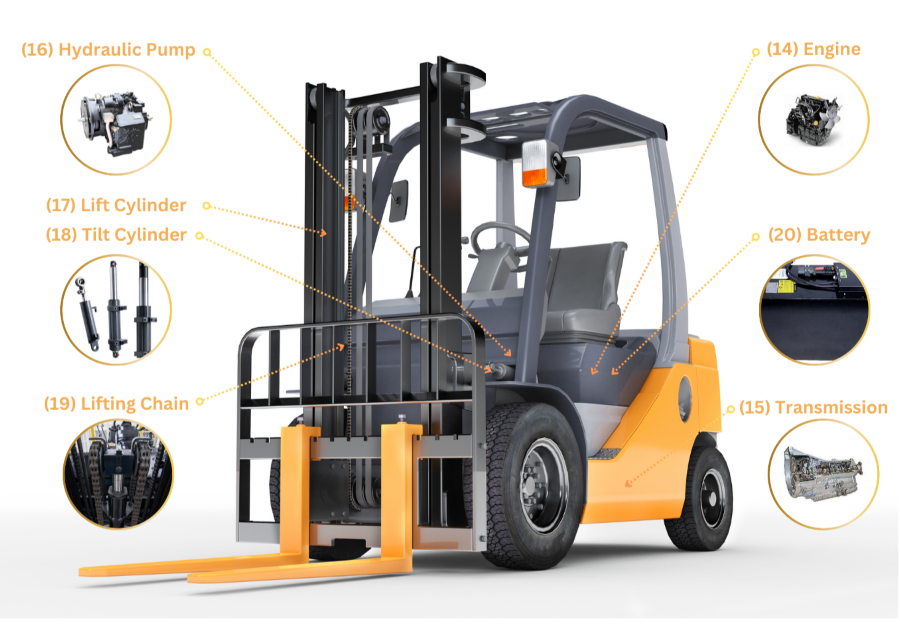(click for direction)
Emergency Number: 0409 900 902
Parts of a Forklift and Their Function
Key Components of a Forklift

These components are externally visible and directly interact with the environment or the operator.
- Mast: The vertical structure that raises and lowers the load.
- Carriage: The platform attached to the mast for mounting forks or other attachments.
- Forks: The horizontal tines that engage and lift the load.
- Counterweight: The weight at the rear that balances the load on the forks.
- Overhead Guard: A protective frame over the operator's head to protect from falling objects.
- Load Backrest: Prevents the load from shifting toward the operator.
- Wheels and Tires: Enable the forklift to move and support the weight of the forklift and the load.
- Drive Axle: Delivers power from the transmission to the wheels.
- Steering Axle: Allows the operator to control the direction of the forklift.
- Operator Cab: The area where the operator controls the forklift.
- Safety Lights and Horns: For visibility and warning signals.
- Seat Belt: Ensures the safety of the operator by keeping them secured within the cab.
- Nameplate: Displays vital information about the forklift's capabilities.
Parts That Power the Forklift
These components are essential for the forklift's operation, powering its movements, and lifting mechanisms.

14. Power Source:
- Internal Combustion Engine: Powers forklifts that run on gasoline, diesel, or propane. The forklift's engine is usually located either beneath the operator's seat or in the front hood area, depending on the forklift's design.
- Electric Motor: Utilises a rechargeable battery for electric forklifts.
15.
Transmission:
Works with the power source to control the forklift's speed and direction. The transmission is typically located between the engine and the rear axle, and it plays a crucial role in converting engine power into usable torque.
16.
Hydraulic Pump:
Powers the lift and tilt functions by moving hydraulic fluid through the system. Typically, forklifts are equipped with a gear-type pump comprising two interlocking gears that rotate to push the fluid in a direction opposite their rotation. The control valve is responsible for directing the fluid to its intended destination using spools and is considered the brains of the system.
17. Lift Cylinder: Enables the mast to raise and lower the load.
18. Tilt Cylinder: Allows the mast to tilt forwards or backwards for load manipulation.
19. Lifting Chain: Facilitates the lifting and lowering of the carriage and forks.
20. Battery (for electric forklifts): Stores electrical energy to power the electric motor and other electrical components
Parts Servicing
Regular maintenance and servicing are crucial for the safety and efficiency of forklift operations. Certain parts of a forklift must be serviced regularly to ensure the machine operates smoothly and safely. Here's a breakdown of the components that typically require routine service:
- Power Source Components.
- Internal Combustion Engine or Electric Motor: Regular checks for oil levels, coolant levels (for combustion engines), battery water levels, and charging systems (for electric models) are vital.
- Battery (Electric Forklifts): Requires periodic checking of water levels, terminal cleaning, and ensuring proper charging to extend battery life.
- Transmission System
- Transmission Fluid: Checking and replacing the transmission fluid according to the manufacturer's recommendations helps maintain smooth operation.
- Mast and Movement Mechanisms
- Lift and Tilt Cylinders: Inspect for leaks or damage to seals and ensure smooth operation.
- Hydraulic Pump and Fluid: Checking hydraulic fluid levels and inspecting for leaks are crucial. The hydraulic pump should also be checked for efficient operation.
- Lifting Chain: Regular inspection for wear and proper tensioning is required to ensure safety and functionality.
- Tires and Wheels
- Tyres: Need regular inspection for wear, damage, and proper inflation (for pneumatic tyres). Worn or damaged tyres can significantly affect the forklift's stability and safety.
- Wheels: Bearings and axles should be inspected for wear and lubricated as needed.
- Steering and Braking Systems
- Steering System: Should be checked for responsiveness and any signs of wear or damage.
- Brakes: Regular inspection for wear, proper adjustment, and fluid levels are essential for safety.
- Safety Features
- Overhead Guard: Inspect for structural integrity and any signs of damage.
- Seat Belt: Check for wear, damage, and functionality.
- Safety Lights and Horns: Ensure all lights and warning devices function correctly.
- General Maintenance
- Filters (Air, Fuel, Hydraulic, and Oil Filters): Should be checked and replaced regularly to ensure clean operation of the engine and hydraulic systems.
- Cooling System (for IC Engines): Inspect the radiator and coolant levels to prevent overheating.
- Nameplate and Operator's Manual: Ensure these are legible and accessible, as they provide crucial information for safe operation.
Regular maintenance not only extends the lifespan of the forklift but also prevents accidents and operational downtime. Always refer to the manufacturer's maintenance schedule and specific service intervals and procedures guidelines. Contact Heavy Forklifts in Melbourne for forklift service and hydraulic repair. We also sell forklift spare parts and accessories.
Need to hire forklift in Melbourne and VIC?
Forklift rentals are cost-effective solutions, and you can consider hiring to meet any seasonal peaks.
Quick Links
Contact info
Address:
826 Mountain Hwy, Bayswater VIC
Emergency Number:
0409 900 902
Phone:
(03) 9762 4965
Follow Us On:
Business Hours
- Mon - Thu
- -
- Friday
- -
- Sat - Sun
- Appointment Only
24-hour emergency
Public holidays: Closed
ABN: 55179159792
Payment Options




